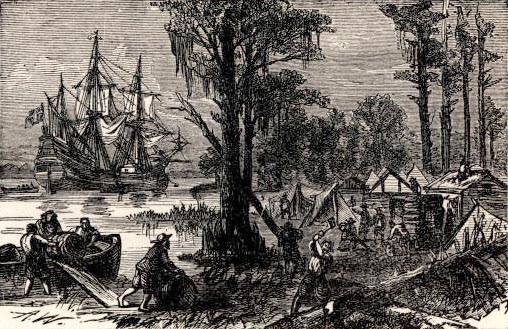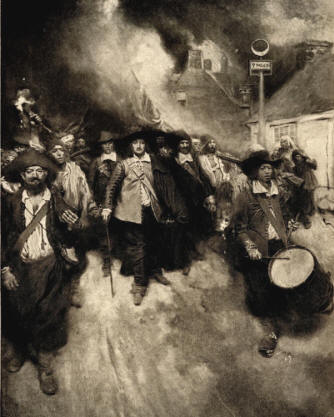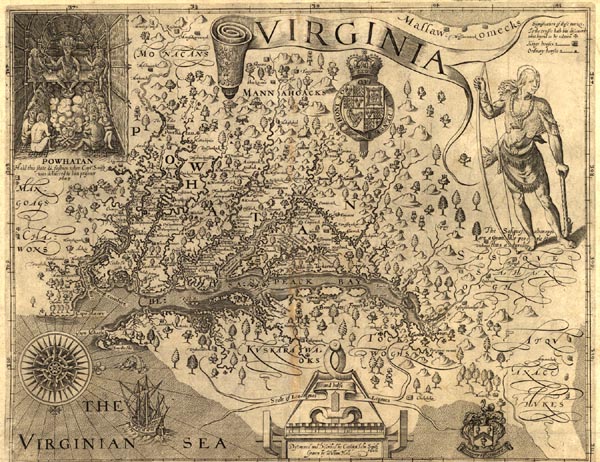Settlement at Jamestown
|
|
This Site:
|
Settlers Arriving at JamestownJamestown. On May 13, 1607, more than 100 Englishmen landed on a slightly elevated peninsula on the left bank of the " River of Powhatan," Virginia, 40 or 50 miles from its mouth; chose the spot for the capital of a new colony; cleared the trees from the ground ; and began the building of a village, which, in compliment to their King (James I.), they named Jamestown. They also gave his name to the river. The spot is more of an island than a peninsula, for the marshy isthmus that connects it with the mainland is often covered with water. The Rev. Robert Hunt, the pastor of the colony, preached a sermon and invoked the blessings of God upon their undertaking. Then, in the warm sunshine, and among the shadowy woods and the delicious perfume of flowers, the sound of the metal axe was first heard in Virginia. The first tree was felled for a dwelling on the spot first settled, permanently, by English men in America. The Indians were at first hostile, and the settlement built a stockade. Their first church edifice there was very simple. "When I first went to Virginia," says Captain Smith, "I well remember we did hang an awning (which was an old sail) to three or four trees to shadow us from the sun; our walls were rails of wood, our seats unhewed trees, till we cut planks ; our pulpit a bar of wood nailed to two neighboring trees; in foul weather we shifted into an old, rotten tent, for we had few better. . . . This was our church till we built a homely thing, like a barn, set upon crotchets, covered with rafts, sedge, and earth; so were also the walls. The best of our houses were of the like curiosity, but, for the most part, of far worse workmanship, that could neither well defend wind nor rain. Yet we had daily common prayer morning and evening, every Sunday two sermons, and every three months communion till our minister died." The church-" the homely thing, like a barn "-was burned while Captain Smith was a prisoner among the Indians, and he found the settlers building a house for the president of the council. When, not long after, he was installed in that office, he ordered the " building of the palace to be stayed, as a thing needless," and the church to be rebuilt at once.
Commissioners under the new charter arrived at Jamestown in the spring of 1610. Of the 490 persons left there by Smith the previous autumn, only sixty remained alive. They had refused to follow the admonitions of Smith to provide food for the winter, but relied upon the neighboring Indians to supply them. When Smith departed, the Indians showed hostility and withheld corn and game. They matured a plan for the destruction of the settlers at Jamestown, when POCAHONTAS, like an angel of mercy, hastened to the settlement under cover of darkness, warned them of their danger, put them on their guard, and saved them. Terrible had been the sufferings of the colonists through the winter. More than 400 had perished by famine and sickness in the space of six months. It was long after referred to by the survivors as " the starving time." The settlers were in the depths of despair when the commissioners arrived. Sir Thomas Gates, who was acting governor, saw no other way to save the lives of the starving men than to abandon the settlement, sail to Newfoundland, and distribute them among the fishermen there. They were embarked in four pinnaces, but, at dawn, they met Lord Delaware, with ships, supplies, and emigrants, at the mouth of the river. All turned back and, landed at deserted Jamestown, they stood in silent prayer and thanksgiving on the shore, and then followed Rev. Mr. Buckle (who had succeeded Mr. Hunt) to the church, where he preached a sermon in the evening twilight. The congregation sang anthems of praise, and were listened to by crouching natives in the adjacent woods. In that little chapel at Jamestown Pocahontas was baptized and married a few years later. The fire that consumed the first church also destroyed a large portion of the town and surrounding palisades. There seems to have been another destructive fire there afterwards, for Smith, speaking of the arrival of Governor Argall, in 1617, says : "In Jamestown he found but five or six houses, the church down, the palisades broken, the bridge [across the marsh] in pieces, the well of fresh water spoiled, and the storehouse used for a church." In the same year Smith's Generall Historic recalls a statement by John Rolfe: " About the last of August came a Dutch man-of-war and sold us 20 Negars." A more desirable accession came in 1621 through the shipment by the company of "respectable young women for wives of those colonists who would pay the cost of transportation "-at first 120 lbs. of tobacco, afterwards 150 lbs. In July, 1620, the colony was 4,000 strong and shipped to England 40,000 pounds of tobacco. This was raised with the aid of many bound apprentices-boys and girls picked up in the streets of London and sent out-and of many " disorderly persons " sent by order of the King." Captain Smith's Jamestown MapSuddenly a great calamity overtook the colony. Powhatan was dead, and his successor, OPECHANCANOUGH, always hostile, planned a blow for the extermination of the white people. It fell with terrible force late in March, 1622, and eighty plantations were reduced to eight. The settlers at Jamestown escaped the calamity through the good offices of Chanco, a friendly Indian, who gave them timely warning of the plot, and they were prepared for defense. Jamestown became a refuge from the storm for the western settlements. Sickness and famine ensued, and the colony was greatly reduced in number, for many left through fear. It soon recovered, and increased in strength. A new and substantial church was built, with a heavy brick tower, probably between 1620 and 1625. During Bacon's Rebellion, in 1676, Jamestown " the only village in all Virginia " was entered by that leader, after driving away the governor, and, in a council of war it was determined to burn the town, a rumor having reached Bacon that the royalist troops were coming upon him. The torch was applied just at twilight, and the Virginia capital was laid in ashes. Nothing remained the next morning but the brick tower of the church and a few solitary chimneys. |
|
|
||
|
|
Site Copyright 2003-2018 Son of the South. For Questions or comments about this collection, contact: paul@sonofthesouth.net |
|
|
Are you Scared and Confused? Read My Snake Story, a story of hope and encouragement, to help you face your fears. |
||


